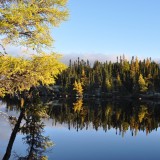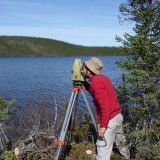Biases in RCS tree ring chronologies due to sampling heights on trees, Julia Autin M. Sc.
The Regional Curve Standardization (RCS) is one of the most employed methods to remove biological signals in long tree ring chronologies used in climate reconstructions. The approach assumes than an overall age-related growth trend typify all tree ring series to be included in a standardized tree ring chronology. Although several potential problems of the method have been examined, the influence of varying the sampling height along tree stems has not been evaluated. Considering that the age-related growth trend may vary with stem height, biases may arise when combining samples from unknown or variable sampling heights, a frequent situation with subfossil logs. We have performed a detailed stem analysis of 15 lakeshore black spruce (Picea mariana Mill. B.S.P.) trees in the taiga of eastern Canada to describe how the age-related growth trend varies with stem height and to quantify resulting biases in RCS chronologies built from living and subfossil trees.
Results show that the age-related growth trend varies markedly and systematically along stems, generating large methodological biases in RCS chronologies, especially near the recent chronology end. These biases may lead to erroneous reconstructions of recent climatic trends, and cause false divergence between tree ring and climate series.



